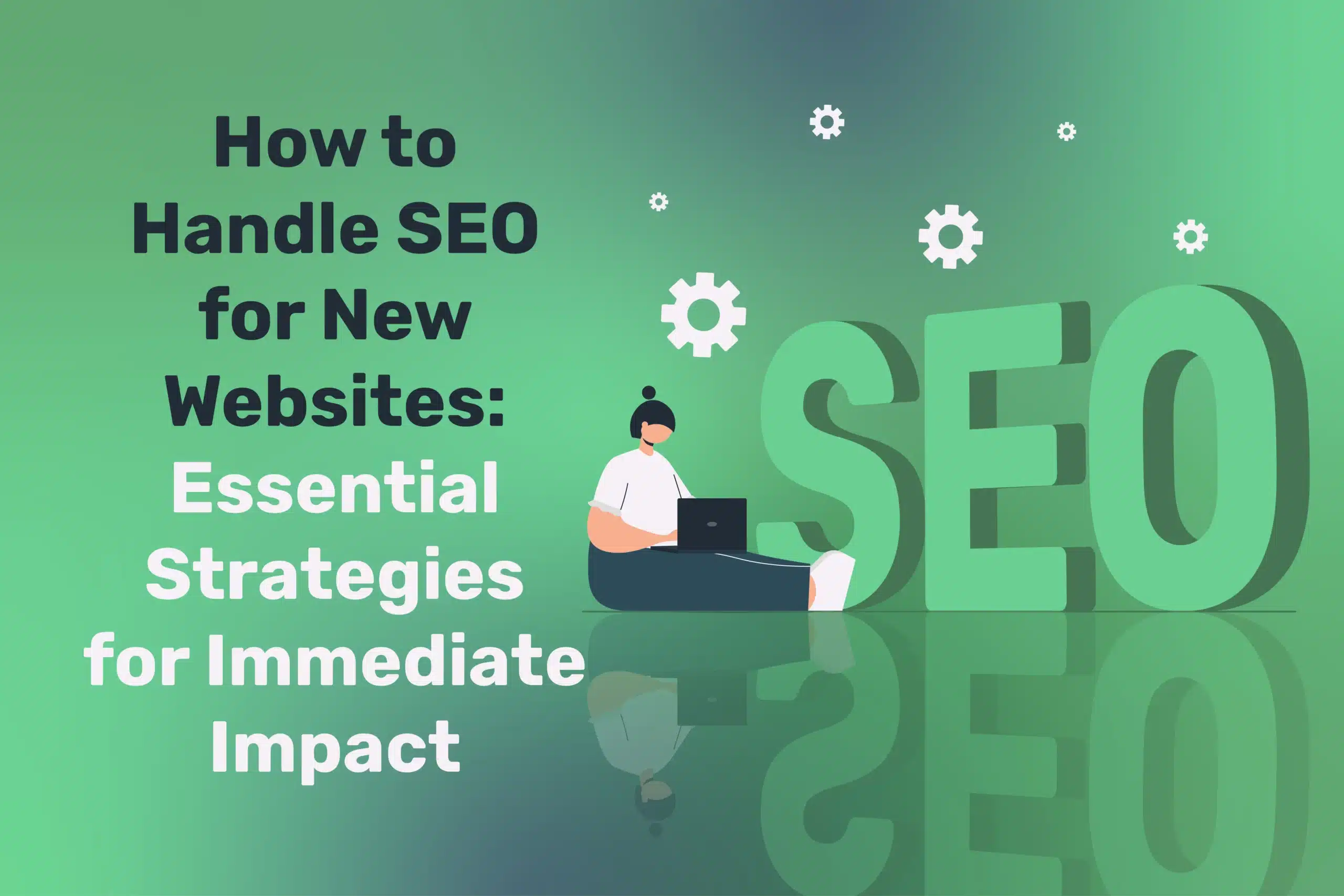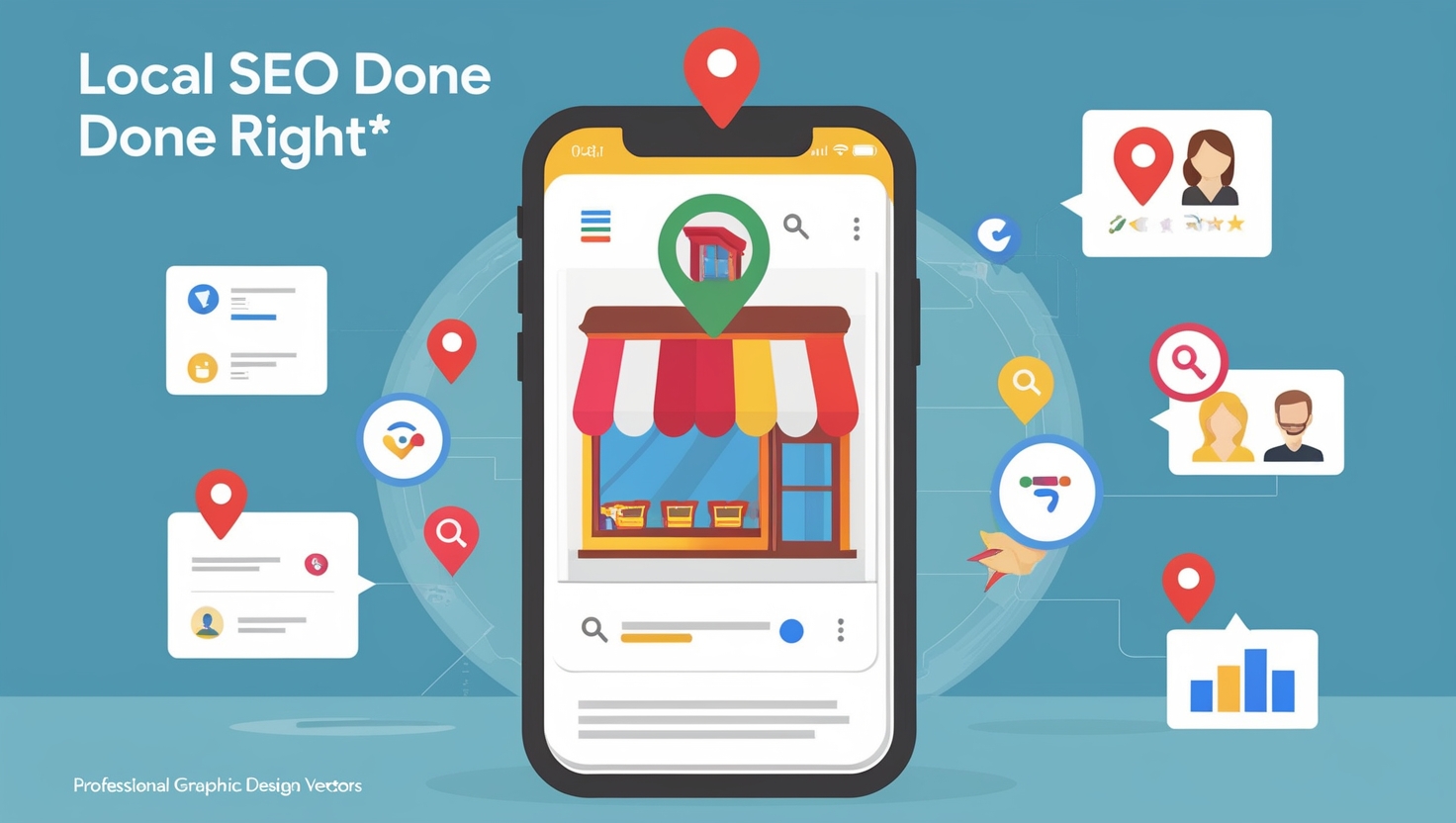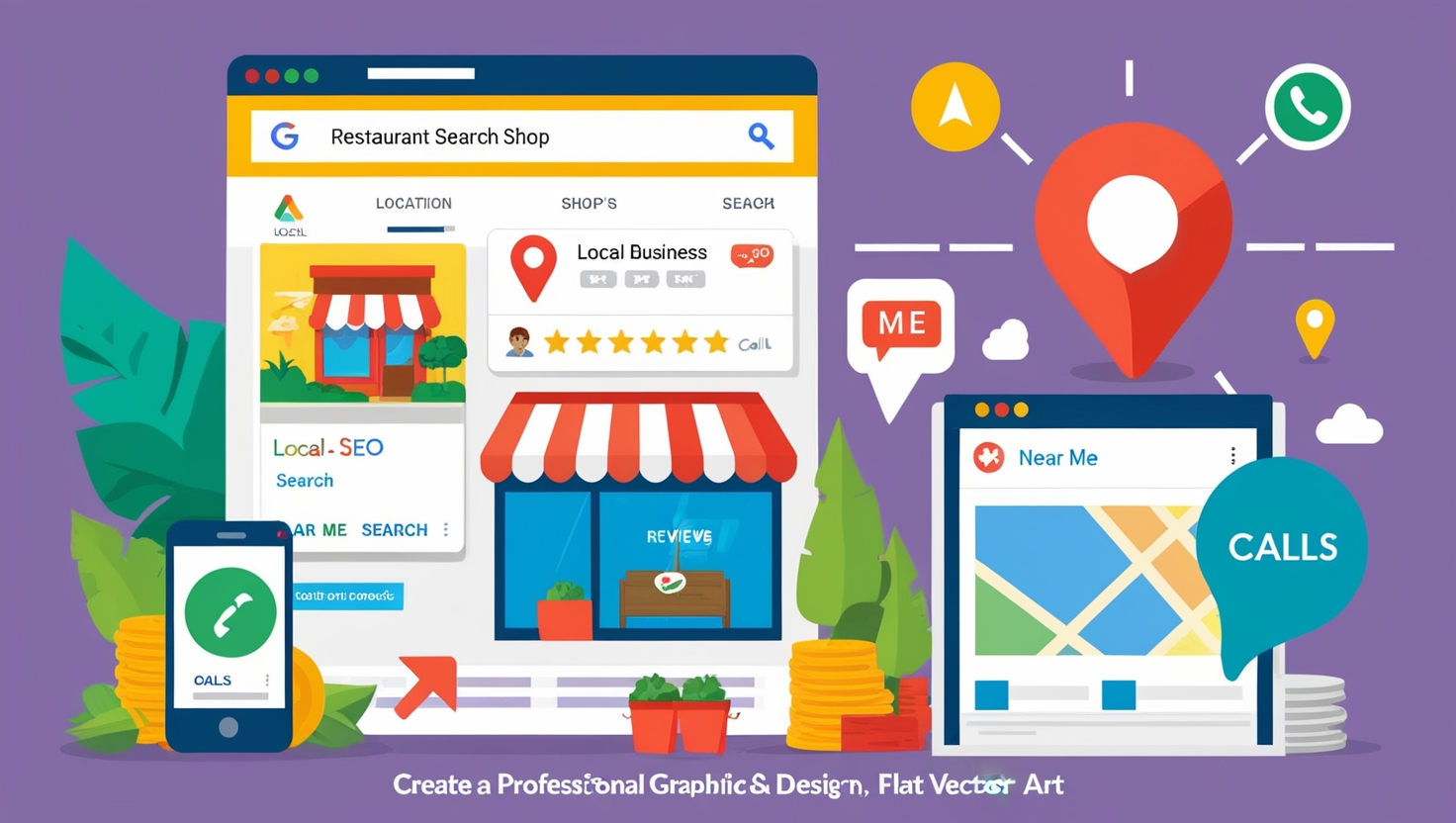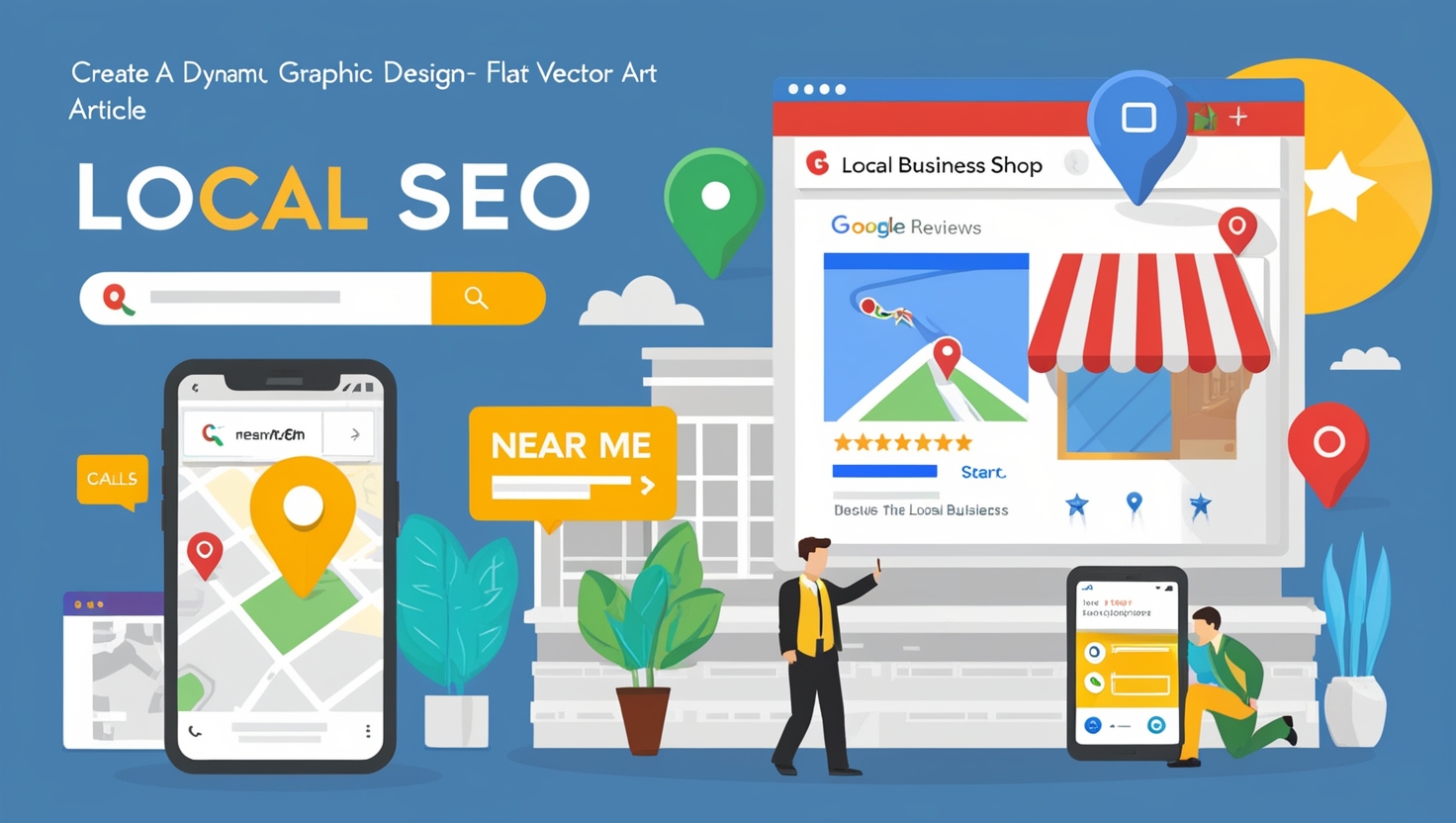
Local SEO Done Right: 10 Ways to Rank Above Competitors in Northern Ireland
Table of Contents
In 2025, search behaviour continues trending hyperlocal—people frequently look for services “near me,” check Google Maps listings, and prefer results highly relevant to their immediate area. Whether you’re a restaurant, law firm, or digital agency with a local presence, local SEO is vital for staying visible to nearby prospects. By refining your site’s local signals and business listings, you can surpass competitors who haven’t optimised for location-based queries.
This article lays out ten proven tactics for a local SEO done right, from on-page strategies to off-site citations and Google Business Profile optimisation. Apply these methods consistently, and watch your brand appear above rivals in Northern Ireland.
“Local SEO ensures you’re top of mind when customers literally search in your backyard. By optimising location signals, you own your corner of search results,” emphasises Ciaran Connolly, Director of ProfileTree.
Optimise Your Google Business Profile
Optimising your Google Business Profile ensures better visibility, engagement, and local search rankings. A complete and accurate profile with high-quality images, detailed business information, and regular updates enhances credibility and attracts potential customers. Encourage positive reviews, respond to enquiries promptly, and utilise relevant keywords to improve discoverability. By actively managing your profile, businesses can boost their local SEO and stand out in search results.
Claim and Verify
The foundation of local SEO is your Google Business Profile (GBP, formerly Google My Business). Begin by claiming, verifying, and populating all relevant info—name, address, phone (NAP), website URL, business category. This step ensures your business can appear in Google’s local pack and Maps results.
Perfect Your NAP Consistency
Ensure exact matching of your name, address, and phone across all mentions (site footer, contact page, other directory listings). Even slight variations like “Street” vs “St.” can cause confusion for Google’s algorithms. Keep NAP data consistent to reinforce authenticity.
Fill in Descriptions and Attributes
Use the description field to summarise your services, brand story, or value proposition. Add relevant attributes—like “Free Wi-Fi,” “Wheelchair Accessible,” or “Family-Friendly”—to help differentiate from competitors. This detail can influence user click-throughs or Google’s local ranking signals.
Upload Photos and Videos
Google often prioritises listings with recent, high-quality images or short clips. Show your storefront, team, products, or services in action. Encourage customers to upload their own pictures. A visually appealing profile catches users’ eyes, driving more calls or route directions.
Regular Updates and Posts
GBP “Posts” feature allows short announcements, event promos, or blog snippet sharing. Fresh updates signal an active, reputable business. Scheduling a monthly post ensures your profile remains lively—especially beneficial for repeating promotions or seasonal deals.
Local Keyword Research

Effective local keyword research helps businesses target the right audience and improve local search rankings. Start by identifying location-specific terms potential customers use, such as “best coffee shop in [city]” or “[service] near me.” Use tools like Google Keyword Planner, Ahrefs, or Ubersuggest to analyse search volume and competition. Incorporate these keywords naturally into your Google Business Profile, website, and content to enhance local SEO and attract more nearby customers.
Start with Basic Terms + Location
Combine your core offerings with local identifiers. For instance, “digital marketing agency in [Town/City]” or “best coffee shop near [Neighbourhood].” Tools like Google Keyword Planner or third-party solutions (e.g., Semrush) can show approximate search volumes for these phrases.
Include Neighbourhood or District Names
If you’re in a large city, potential customers often specify neighbourhoods or districts. E.g., “Plumber in Manchester city centre” or “Mechanic near Didsbury.” Create service pages or blog posts referencing these sub-areas to capture hyperlocal traffic.
Map Out Peripheral Keywords
Apart from direct service terms, note related queries—like “cost of wedding photography in [City],” “24-hour emergency dentist [Area].” Answering these in blog posts or FAQ sections can drive additional local leads. Consider synonyms—like “repairs” vs “fix,” “tailor” vs “seamstress.”
Track Trends Over Time
Seasonal shifts or major local events can alter search patterns—like “summer restaurant deals [City]” or “Christmas hamper delivery near me.” An annual editorial calendar helps you pre-plan content or special landing pages aligned to these trends.
On-Page Local Optimisation
On-page local optimisation boosts visibility by using local keywords in titles, meta descriptions, and headers. Add Google Maps, schema markup, and location-specific content. Ensure mobile-friendliness and fast loading for better rankings.
Geo-Specific Landing Pages
If you serve multiple areas, consider separate landing pages for each location. Each page should contain unique details: local keywords, local testimonials, a map embed, region-specific imagery. Avoid duplicating the same text or you risk internal competition or a Panda-like penalty for thin content.
Embed a Map and Contact Info
A live Google Map or a pinned location fosters user trust and direct route requests. Alongside that, place your consistent NAP data, business hours, and any clickable call buttons for mobile users. This layout clarity signals to search engines and visitors that you’re genuinely local.
Localised Title Tags and Meta Descriptions
In your HTML head, incorporate city or region mentions in title tags—e.g., “Wedding Florist in [City] | ABC Florals.” The meta description can highlight a local selling point—“Serving brides in [Neighbourhood] for over 10 years.” Avoid keyword stuffing; maintain readability.
Schema Markup
LocalBusiness schema can detail your address, opening hours, and more to help Google interpret your site’s local context. If you’re a restaurant, use Restaurant schema for menus, star ratings, or cuisine type. Tools like Google’s structured data testing tool confirm correct implementation.
Consistent Citations and Directories

Consistent citations across online directories strengthen local SEO and credibility. Ensure your business name, address, and phone number (NAP) match across platforms like Google, Yelp, and industry-specific directories. Regular updates prevent discrepancies that could hurt rankings and customer trust.
Build/Reinforce Citations
Citations are mentions of your NAP across online business directories—Yell, Yelp, CityLocal, or industry directories. Consistency is crucial. Even minor discrepancies can confuse Google. A thorough citation strategy can boost local trust signals.
Target Industry-Specific Directories
Aside from general directories, look for niche directories relevant to your sector. E.g., healthcare listings for clinics, wedding directories for photographers. These typically yield higher-quality traffic and signals. Ensure each listing is up-to-date with consistent brand descriptions.
Clean Up Old or Duplicate Listings
Over time, your business might have old addresses or phone numbers floating around. Manually correct or merge duplicates. Tools like Moz Local or BrightLocal can automate the process or help you track down rogue citations. This upkeep avoids contradictory location signals.
Encourage Relevant Categories
Many directories let you select categories or tags. Choose the most relevant ones, reflecting your main services—like “Dentist,” “Emergency Dental,” “Cosmetic Dentistry.” This specificity ensures your listing surfaces for the right local queries.
Reviews and Reputation Management
Online reviews play a vital role in shaping your business’s reputation and local search rankings. Positive feedback builds trust and attracts new customers, while negative reviews—if handled correctly—can demonstrate strong customer service. Actively managing reviews by encouraging satisfied customers to share their experiences and responding thoughtfully to all feedback helps maintain a strong online presence and boosts local SEO performance.
Encourage Customer Reviews
Positive Google reviews, Yelp testimonials, or Facebook recommendations strongly influence local rankings and user trust. Politely ask satisfied customers to share experiences. Provide direct links or QR codes. Avoid incentivising reviews in ways that violate platform guidelines.
Respond to All Feedback
A business actively replying to both positive and negative comments shows engagement. Professional, empathetic responses can mitigate negative reviews’ impact. Thanking positive reviewers fosters loyalty and might encourage future reviews. Some prospective customers read these dialogues before deciding.
Review Velocity and Diversity
Sudden spammy floods of reviews appear suspicious. Aim for a consistent flow. Also, gather feedback on multiple platforms—Google, TripAdvisor (if relevant), Facebook—to spread your presence. If you see recurring issues in negative comments, fix them promptly.
Showcasing Testimonials
Embed top local reviews on your site. Potential customers trust real user endorsements more than brand claims alone. Use structured markup (Review schema) if feasible, letting star ratings appear in SERPs for your product or service pages.
“Active review management is a double win. It builds trust for browsers while boosting local ranking signals in the eyes of search engines,” notes Ciaran Connolly.
Local Link-Building Tactics
Local link-building boosts SEO by earning backlinks from reputable local sources. Partner with nearby businesses, sponsor community events, and get listed in local directories. Engaging with local blogs, news sites, and industry associations also helps build high-quality links that improve search rankings.
Partnerships with Nearby Businesses
Co-sponsor events or promotions with a complementary local brand. E.g., a gym partners with a health food store to host a community fitness challenge. Each partner links to the other’s site in promotional blogs, strengthening local link profiles.
Local Sponsorships and Press
Sponsor a charity run, local youth sports team, or festival booth. You typically receive a link from the event’s official website. Moreover, local news outlets might feature your involvement, generating editorial backlinks from high-authority local domains.
Guest Blogging on Local Sites
Offer to write a short piece for a local chamber of commerce blog or a neighbourhood association site. Provide helpful industry tips relevant to that community. This fosters local brand visibility and yields a valuable link.
Leverage Testimonials
If you use services from a well-known local supplier, volunteer a testimonial. Often, they’ll post your praise on their site with a link back. This reciprocal approach can build genuine ties while boosting domain authority.
Mobile-Friendly Optimisation for Local Searches
Optimising for mobile ensures a seamless experience for local searches. Use a responsive design, fast-loading pages, and click-to-call buttons. Ensure easy navigation, readable fonts, and location-based content to enhance user engagement and local SEO.
Responsive Web Design
More than half of local queries come from mobile. Ensure your site loads fast, with clear tap targets and minimal clutter. Google penalises slow or unresponsive pages in mobile search.
Click-to-Call Buttons
Local searchers often want immediate contact. Prominent “Call Now” or “Book Online” buttons expedite conversions. Avoid forcing them to hunt for phone numbers or fill lengthy forms.
Easy Directions and Hours
Embed a “Get Directions” link opening Google Maps. Keep your hours of operation updated—especially if they change seasonally. If potential visitors see outdated hours, they may choose a competitor.
Voice Search Considerations
Voice search queries often use conversational phrases—like “Where can I find the best vegan pizza near me?” Incorporate natural Q&A content in your site’s FAQ or blog, capturing these voice-based leads.
Local Content Marketing

Local content marketing boosts engagement and SEO by creating region-specific blogs, event coverage, and community stories. Share customer testimonials, local guides, and industry news relevant to your area. Optimising content with local keywords strengthens visibility and attracts nearby audiences.
Location-Focused Blog Posts
Create blog content that addresses local events, cultural highlights, or location-specific tips. E.g., “A Local’s Guide to Summer Activities in [City],” weaving in how your services fit in. This can rank for broader city + topic queries.
Community Engagement on Social
Regularly post about local happenings or philanthropic efforts on social media, using geo-based hashtags or location tags. This fosters local brand loyalty and may get shared in community groups.
Video Walkthroughs
Record short clips—like a virtual tour of your storefront or introduction to your local staff. Upload to YouTube and embed on your site. Accompany with text referencing your city or neighbourhood. This approach enhances user trust.
Host or Attend Local Workshops
Whether offline or online (webinars with a local focus), hosting workshops positions you as a local authority. Recaps, slides, or event pages can rank well if local professionals or media link back to them. Plus, the offline synergy can yield brand mentions in local news or directories.
“Authentic local content resonates with both search engines and real people. Show genuine community ties, and rankings often follow,” adds Ciaran Connolly.
Tracking and Measuring Local SEO Success
Track local SEO success using tools like Google Analytics, Google Search Console, and Google Business Profile Insights. Monitor local rankings, website traffic, and engagement metrics. Track calls, direction requests, and reviews to measure customer actions. Regularly analyse data to refine your strategy and improve local visibility.
Google Search Console and Analytics
Monitor impressions, clicks, and average positions for location-based queries. Segment your data by geography if possible. Evaluate dwell time, bounce rate, and conversions from local landing pages.
Google Business Profile Insights
Google Business Profile (GBP) dashboards provide insights into calls, website clicks, and direction requests from your listing. Analysing trends—such as peak engagement times or user device preferences—can help refine business hours, optimise ad targeting, and improve customer experience. Adjusting your strategy based on these data points ensures maximum local visibility and engagement.
Local Rankings Tools
Use dedicated rank trackers like Brightlocal or SEMrush’s local tracking to monitor your search positions across different postcodes or neighbourhoods. This granular data helps identify areas needing extra SEO attention or spots where competitors are outperforming you. By analysing these insights, you can refine your strategy, optimise content, and strengthen your presence in underperforming locations.
Conversion Goals
Set up phone call tracking or contact form funnels in Google Analytics. A local lead might land on your site, browse a service page, then call. Tying conversions back to local keywords or page visits helps justify your local SEO investments.
Staying Competitive Long-Term

To stay competitive long-term in local SEO, continuously update your Google Business Profile, refine local keywords, and build quality backlinks. Keep up with algorithm changes, monitor competitor strategies, and engage with customer reviews. Consistently producing local content and optimising for mobile ensures sustained visibility and growth.
Regular Reviews of NAP + Directories
As businesses grow or relocate, address changes or new phone lines can cause citations to drift out of sync. Quarterly audits keep everything consistent. A single old listing can hamper local trust signals.
Responding to Competitor Moves
Competitors may increase local ads, enhance content marketing, or refine their Google Business Profile (GBP). Stay ahead by tracking their link-building efforts and profile updates. A proactive strategy—such as publishing fresh local blog posts, engaging in new event sponsorships, and optimising your listings—helps maintain your competitive edge in local search rankings.
Embrace New Google Features
Keep up with Google’s evolving local features, such as Q&A sections, local service ads, and visual map updates. These enhancements can significantly impact visibility in local search results. By adopting new features early, businesses can gain a competitive edge, securing prime positions before the local pack becomes more competitive. Regularly monitoring Google’s updates ensures you stay ahead of trends and maximise local SEO opportunities.
Expand Your Service Radius
After establishing dominance in your immediate area, expand into nearby towns or regions. Create dedicated location pages or curated local directories to target new audiences. Apply the same local SEO principles—optimising keywords, citations, and backlinks—while tailoring content to each area’s unique characteristics and search trends. This strategic expansion helps sustain growth and strengthens your regional presence.
Local SEO Done Right: Becoming a Local Authority
Local SEO has evolved beyond a basic Google Business listing. It requires consistent citations, geo-specific content, a well-structured site, and active engagement with users—through reviews, social channels, and offline involvement. By focusing on on-page elements (location landing pages, schema) and off-page factors (reviews, local links, citations), you can outrank competitors who underestimate the power of local optimisation.
In 2025’s digital environment, dominating your immediate region or city sets a solid foundation to expand further. Start with your existing presence, refine each detail, and measure the results methodically. Over time, these local signals will cement your brand as the go-to choice in Northern Ireland, ensuring a steady flow of high-intent visitors ready to convert.




